Content
Diseases of the eyes in rabbits and their treatment
Rabbit breeding has become very popular lately. As a popular joke goes, "rabbits are not only valuable fur, but also 3-4 kilograms of dietary, easily digestible meat."
Well, on top of that, there are also lovers of decorative rabbits, for whom these cute animals become real friends. Like any living creature, these pussies can get sick from time to time. The article will focus on possible eye diseases in rabbits, how to prevent, recognize in time and how to treat.
Existing eye diseases in the rabbit
The eyes of rabbits are naturally endowed with the ability to see almost 360 degrees around. This feature helps animals in the wild to see the approach of the enemy in time. Therefore, the organ of vision is extremely important for these animals. Eye diseases in rabbits can be roughly divided into three categories:
- caused by birth defects;
- infectious nature;
- inflammatory diseases;
The treatment is selected depending on. Sometimes, treatment is possible only through surgery... In some cases, the animal is only subject to euthanasia.
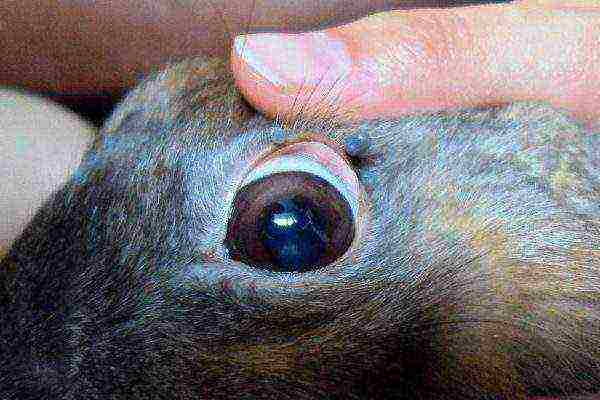
How to treat conjunctivitis if the eyes are watery, festering and sour?
A fairly common eye disease in humans is also found in our younger brothers. Conjunctivitis in rabbits is both bacterial and infectious, as well as allergic. Treatment is selected depending on the type of disease. The allergic type occurs against the background of allergies, the main symptom that distinguishes this type from other forms is the presence of itching.
It is treated with antihistamines, which are selected by a veterinarian. Infectious occurs due to foreign small particles entering the eye. Often, the inflammatory process occurs against the background of a lack of vitamin A. With this form, there is swelling and redness of the mucous membrane, the eyes are intensely watery. The diseased organ of vision should be treated with a weak solution of boric acid or manganese.
Purulent conjunctivitis is caused by pathogenic bacteria. In rabbits, eyes fester or turn sour; with a neglected form, the animal is not able to open the eyelids. Treatment requires washing with antiseptic solutions in order to remove accumulated pus, as well as antibacterial treatment as prescribed by a doctor. Usually the antibiotic is selected after a resistance test has been taken.
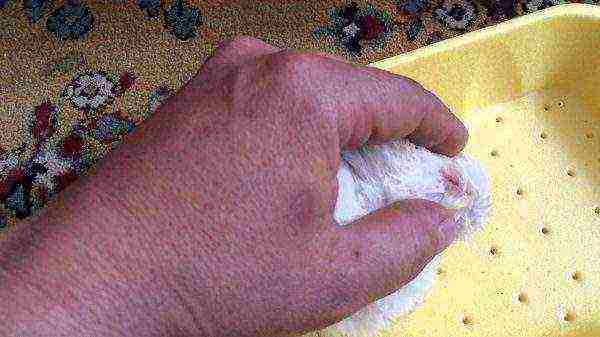
What to do with myxomatosis?
This disease belongs to the types caused by birth defects. It manifests itself as purulent conjunctivitis, the formation of tumors on the nose is possible. With this diagnosis, the upper eyelid is not of the usual shape, but wavy. In this case, improper growth of eyelashes provokes inflammation of the conjunctiva.
Usually observed in rabbits up to 14 days old. The treatment consists in plastic surgery of the eyelid. The reasons for the appearance of such anomalies have not been established. There are suggestions that this is justified by a genetic predisposition.Another version is that such a mutation is caused by some still unexplored species of bacteria or viruses.
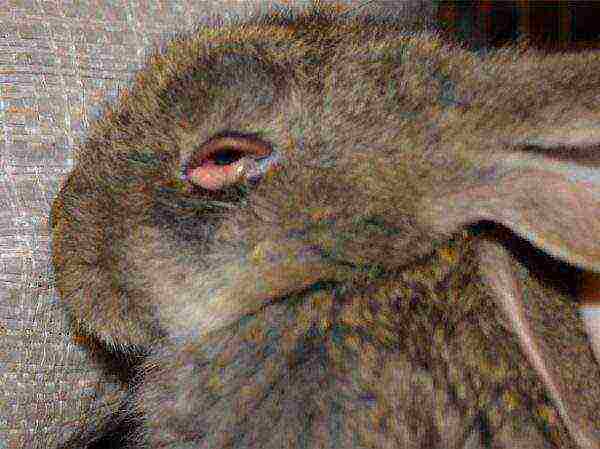
Cataract
The causes of the disease may include diabetes mellitus, especially in the elderly, bacteria, as well as encephalitis. Symptoms include clouding of the eye lens. It is treated depending on the cause.
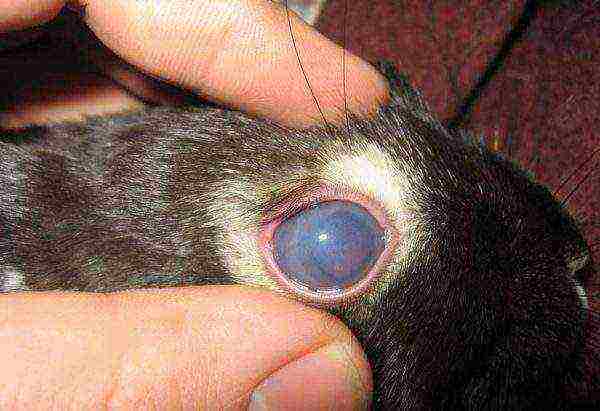
Glaucoma
Ailment against the background of increased intraocular pressure. The only evidence of this is the bulge of the eye itself. The condition is very painful, visual acuity is impaired, is more common in old rabbits, but in some cases it can be congenital. Most often, the affected organ must be removed, in more rare cases, supportive therapy is prescribed.
You may also be interested in the following articles on the rabbit topic:
- The main reasons for the treatment of diarrhea in rabbits.
- Treatment and prevention of rhinitis in rabbits.
- The main diseases of the ears in rabbits.
Keratitis
Inflammation of the cornea. With this ailment, the cornea becomes cloudy, the sick animal has photophobia and purulent discharge, lacrimation. Treatment is carried out with antibacterial ointments or antiseptic cleansing solutions. Additionally, anesthetic is used
Uveitis
The causes of the disease can be in head injuries, viral or bacterial infections. The disease can be chronic. Symptoms include an increase in pupil size on the background of photophobia, iris edema and lacrimation.
In the chronic form, the appearance of an adhesion process of the iris and lens, inflammation of the retina is possible. It is treated with the use of anti-inflammatory drugs, as well as atropine-based drugs to eliminate adhesions.
How to cure exophthalmos?
Certain ophthalmic diseases in rabbits can be associated with teeth. Why is this happening? So, dental inflammation against the background of improperly ground teeth in these animals leads to exophthalmos - an ailment in which the eyeballs literally go out of the orbits. The only possible way to alleviate the condition of the animal in this case consists of removing the affected organ of vision, as well as the tooth, contributing to the development of the problem.
Disease - dacryocystitis
The inflammatory process caused by obstruction of the lacrimal canal is called dacryocystitis. It is often found in young rabbits. In newborn animals, the problem usually goes away by itself, with good care.
In the clogged lacrimal canal, pathogenic bacteria begin to actively live, as a result of which pus is often released from under the eyelid. As a treatment, drops with an antiseptic effect are used to suppress the growth of bacteria.
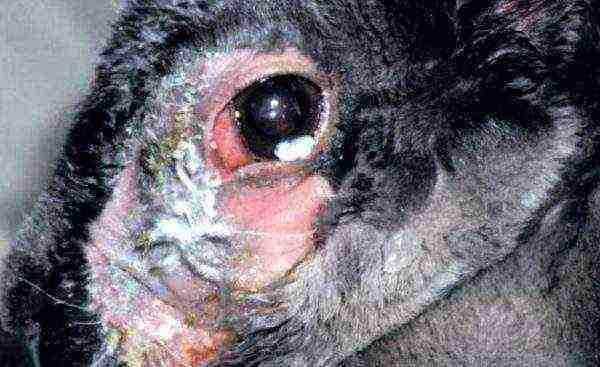
Why does a corneal ulcer occur?
Most often, corneal ulcers occur due to mechanical damage. For example, during a fight with other animals, but there are other reasons that only a qualified veterinarian can determine for sure. For example, ulcers can be the result of chronic blepharoconjunctivitis.
With a corneal ulcer, damage to the corneal epithelium is visible with the naked eye. The process is accompanied by swelling of the eyelids, tearing. In the absence of adequate therapy, organ loss can occur literally within a few days.
Epiphora treatment
Epiphora is similar in symptomatology to dacryocystitis. With this ailment, there is a blockage of the lacrimal canal. Often the inflammatory process is caused by excessive growth of the roots of the teeth, namely the incisors, which results in a blockage of the nasolacrimal passages. Some congenital defects, for example, twisting of the eyelids, abnormal growth of cilia, can also lead to the disease.
Medical appointments are made by a veterinarian based on the cause of the disease. In the event that the problem is caused by improper tooth growth, the teeth must be removed. In other cases, the lacrimal ducts are washed, antibiotic therapy is prescribed.
Prevention of the occurrence of rabbit eye diseases at home
How to cure eye diseases in a rabbit at home? To prevent ophthalmic problems in animals, it is recommended to approach the issues of keeping rabbits responsibly. A number of basic rules that must be followed by the breeder of these cute and affectionate animals:
- Placing a cage with eared tetrapods in a draft-free area.
- A good diet rich in vitamins and minerals, in particular food fortified with vitamin A.
- Timely vaccination.
Conclusion
Now you know what to do if your rabbit has swollen or festering eyes and bumps on the ears. The health of rabbits largely depends on how much the owner invests in the efforts associated with love and care for his pet.
Good care, timely preventive measures and a sincere affection for a four-legged eared friend are the key to a long and healthy life of a furry. The main thing to remember is that we are responsible for those we have tamed


